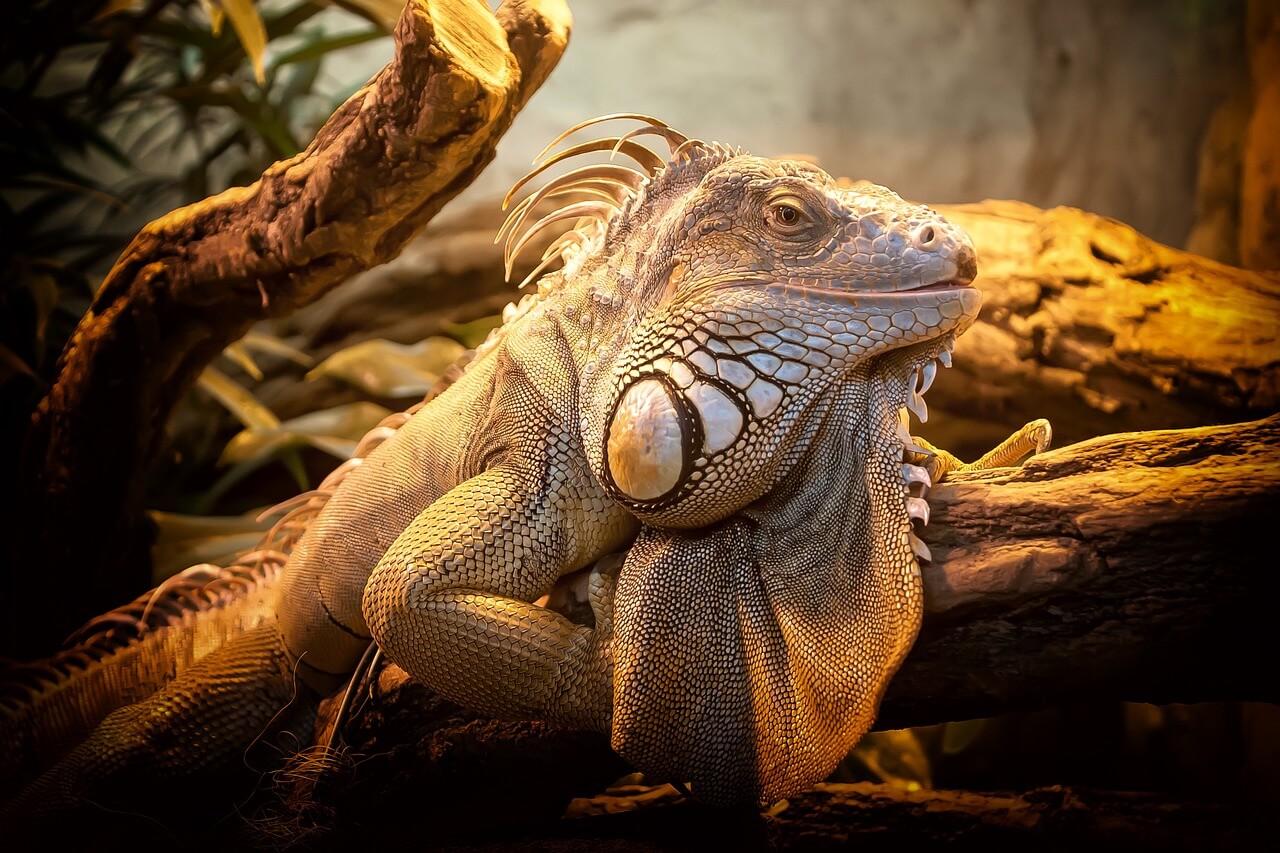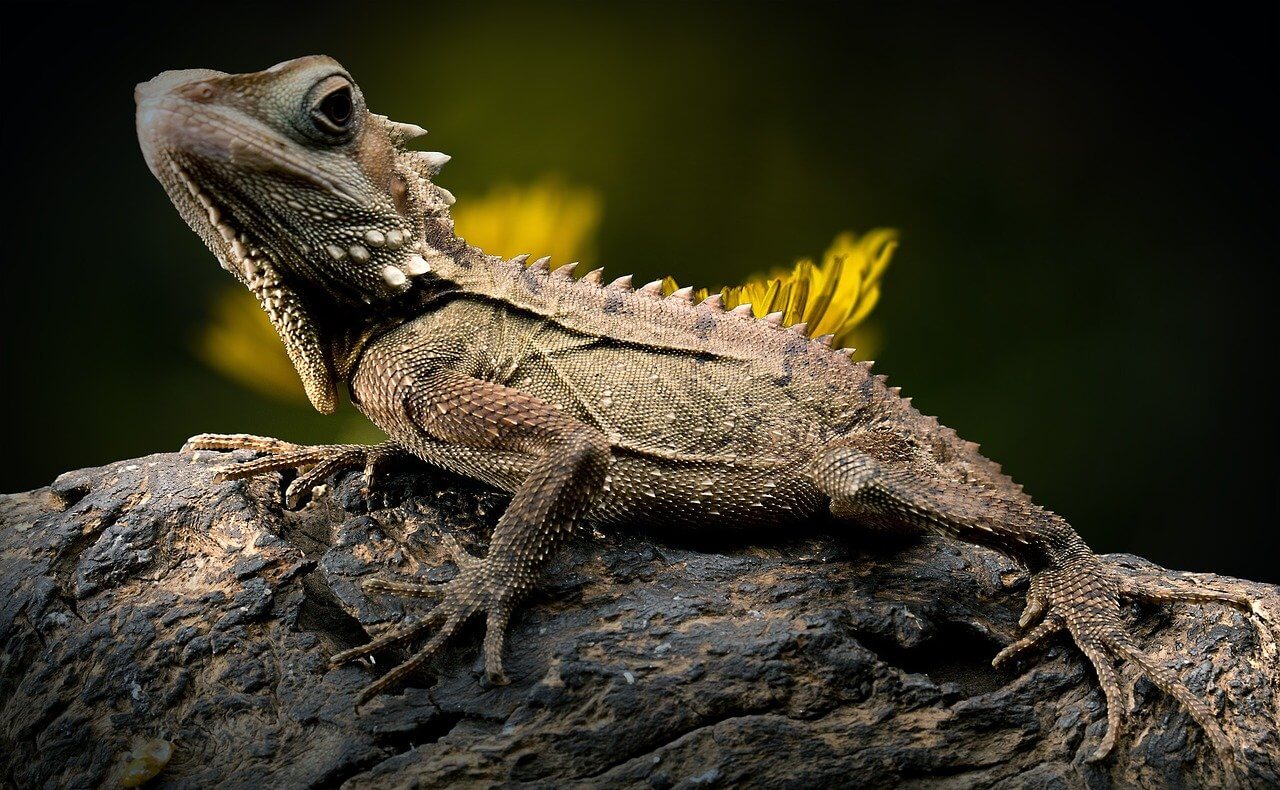What is the classification and types of lizard? Information about the description, characteristics, distrubition of lizards.
LIZARD, any of a large group of scaly reptiles related to snakes. Lizards are the most abundant of all reptiles and are found throughout the world in tropical and temperate areas. There are about 3,000 species of living lizards, including such well-known types as geckos, chameleons, gila monsters, iguanas, and skinks. Lizards far exceed snakes—the next most numerous reptile— in number of individuals. Except under special circumstances, snakes are something of a rarity even when one looks for them; lizards, on the other hand, seem to be everywhere in many of the warmer parts of the world.
Fossils of lizards are also known, some dating from Triassic times, some 180 million years ago. Except for extinct mosasaurs and their relatives, which lived in the oceans and grew to lengths of at least 20 feet (6 meters), extinct lizards were probably not greatly different from lizards living today.

Economic Value.
The skin of many larger lizards, such as iguanas, chuckwallas, and monitors, is used for leather goods, such as handbags, wallets, and shoes. Lizards are also used for food, especially among impoverished peoples, and in some agricultural areas they serve an important role in insect control. Some lizards are also kept as pets.
Relationship with Snakes and Other Animals. Several features reveal the close relationship between lizards and snakes, the most important of which is the possession of two copulatory organs, called hemipenes, in the males. Many male vertebrates have no copulatory organs; some have one; but only lizards and snakes have two. Lizards and snakes are also alike and distinguishable from all other reptiles except the tuatara in having a transverse anal opening.
No single feature distinguishes lizards from snakes—not even legs, since some lizards lack limbs of any kind. However, unlike snakes, lizards usually have the following characteristics: a pectoral, or shoulder, girdle, that is, a skeletal support for the attachment of front limbs; movable eyelids; an external ear opening, an eardrum, and a middle ear cavity; and a different skull structure with more skull bones.
Lizards are also often confused with salamanders, amphibians that they sometimes superficially resemble. Salamanders, however, have an elongate or round anal opening, smooth rather than scaly skin, and no more than four fingers on the front limb, rather than the lizard’s usual five.
DISTRIBUTION
Although lizards occur as far north as the Arctic Circle in Europe and as far south as Tierra del Fuego in South America, they are more common in warmer areas, and in North America they barely reach extreme southern Canada. They occur on most landmasses, insular as well as continental, in temperate and tropical regions. In general, they increase in diversity as well as in abundance toward the tropics.
Lizards are found from sea level to altitudes of 17,750 feet (5,305 meters) in the Himalaya, 16,500 feet (5,030 meters) in the Andes, 13,250 feet (4,040 meters) in Mexico, 10,500 feet (3,-200 meters) in western North America, and 9,850 feet (3,005 meters) in the Alps.
Lizard species in general are rarely introduced into new territories. However, some tropical and subtropical geckos are readily transported between continents and islands by natural rafts and inadvertently by man, and some are now widely distributed throughout warm regions of the Atlantic and others throughout warm regions of the Pacific; however, none range into both regions. Skinks, anoles, and lacertids have also been introduced to new areas to a limited degree.
APPEARANCE AND ADAPTATIONS
Lizards are extremely varied in form. There are long, slender, snakelike racers; earthwormlike burrowers; stumpy-tailed, short-bodied rock dwellers; long-tailed varieties capable of running swiftly on sand, earth, and the surface of water; lumbering monsters living on land or in trees; spiny, pancake-shaped species; slick-skinned, agile tree climbers and burrowers, and still others too varied and numerous to describe.
The smallest lizards are certain geckos (Sphaerodactylus) that are about % inch (1.9 cm) long—the smallest of all reptiles. The largest lizards are the Komodo monitors, about 9 or 10 feet (2.7-3.0 meters) long. Most are, however, less than 15 inches (37 cm) long.
In several lizard families, especially the more advanced ones, there are no external differences between the sexes. In other types of lizards, however, there are some discernible differences between the sexes. Males of certain species, for example, have a somewhat enlarged head correlated with enlarged jaw muscles, and some have highly developed preanal pores. In most iguanas, males can be distinguished by their somewhat enlarged scales just behind the anus; in anoles, by their well-developed dewlap; and in some geckos, by postanal spurs and sacs. In some lizards, certain, though often minor, differences in color pattern may occur, with one sex showing a heightening of color, at least during the breeding season.

Scales and Glands.
The body of a lizard is covered with an epidermal layer of more or less horny keratin in the form of relatively thick, inflexible scales. The scales are separated from one another by thinly keratinized, flexible skin. The scales vary greatly in shape and roughness: primitive lizards generally have small scales, and more advanced lizards have larger plates. Plates and larger scales are sometimes accompanied by bony plates (osteoderms), shaped much like the epidermal elements but lying in the dermis under them. A very few small surfaces of the lizard body lack epidermal scales. For example, the so-called “mite pockets”—where the neck and limbs join the body—are partly bare-skinned. Some lizards have fused, transparent eyelids similar to contact lenses.
Like other reptiles, lizards have very few integumentary, or skin, glands. Paired scent glands are present at the base of the tail. In addition, many species have “femoral” or “preanal” pores occurring in a row on the ventral surface of the thigh and in rows or patches in front of the anus. These pores, or glands, are well developed only in males, being vestigial or absent in females. In mature males during the breeding season, a horny core grows out from each pore. This core produces a comblike structure that the male rubs against the female, presumably to stimulate her sexually.
Limbs.
The limbs of lizards, especially the fingers and toes, show a wide variety of environmental adaptations. Some climbing species, for example, have broad pads on the feet to help them adhere to smooth surfaces. Most species have claws, but the claws may be long or short, slender or stout, depending on the species’ environment and way of life. Desert-dwelling species generally have long limbs and fringes along the toes to aid them in getting a purchase on shifting sands; some water-dwelling types have the same adaptations. Slow-moving land types, on the other hand, tend to have short fingers and toes and heavy limbs, and some burrowing types have only greatly reduced limbs or none at all.
Tail.
The tail is as useful to a lizard as one of its limbs. In length it ranges from a scarcely visible nubbin to a structure several times the length of the body. In structure it ranges from a flattened leaflike affair to a whiplike or heavy, clublike form complete with rings of heavy spikes.
The tail has many uses. It serves as a balance for the body, especially in lizards that run on their hind legs with the forepart of the body in the air. It is prehensile in some, grasping or hooking onto twigs or rough areas as the lizard climbs trees or cliffs. The tail also stores fat for use during winter hibernation and seems capable of absorbing moisture. In some species, the tail is brightly colored, serving as an ornament or aiding in camouflage. Some lizards wave the tail over the head, exposing a brightly colored underside, as a warning or deceptive device, and some, particularly those with spiny tails, use the tail for defense.
The most amazing use of the tail is, however, in escape from predators. Most lizards can break the tail at will at any desired point, usually fixed, however, by the point at which a blow is received. The break occurs at a specially adaptqd fracture plane near the middle of a vertebra.’ There, muscles contract the blood vessels and permit little blood loss. The dismembered tail gyrates conspicuously, attracting the attention of the enemy while the lizard is able to slip away unnoticed.
The lizard soon regenerates a new tail, usually shorter than the old one, but one that can again be used for escape if the need arises. The vertebrae are not regenerated, but a cartilaginous rod replaces the lost vertebrae. Species lacking the fracture plane cannot break off their tail and do not regenerate a new tail if theirs is accidentally cut off.
The tail serves yet another unusual function. Hungry lizards have been known to break off the tail deliberately and eat it or to return to the site where the tail was lost and eat any remaining parts.
CLASSIFICATION AND TYPES OF LIZARDS
Lizards make up the suborder Sauria, and together with snakes (suborder Serpentes) and am-phisbaenids (suborder Amphisbaenia), constitute the reptile order Squamata. The over 3,000 lizard species are usually classified in 19 families.
- Agamids (family Agamidae) and Iguanas (family Iguanidae) are rough-scaled lizards with good color-changing ability. They abound in the jungles and desert regions of the tropics and subtropics, agamids exclusively in the Eastern Hemisphere and iguanas mostly in the Western Hemisphere.
- Anguinids (family Anguinidae), all long-tailed lizards with slender or reduced limbs or none, are found in many regions of Europe, Asia, and the Americas.
- Chameleons (family Chameleontidae), found mostly in Africa and Madagascar, are well known for their extensive color-changing ability, but they also have other unusual characteristics.
- The Earless Monitor (family Lanthanotidae), a unique species living in Borneo, somewhat resembles an alligator. It was once erroneously thought venomous.
- Flap-footed Geckos (family Pygopodidae), restricted to New Guinea, Australia, and Tasmania, have only flaplike hind legs and may be the ancestral form from which snakes evolved.
- Flap-footed Skinks (family Dibamidae) occur from southern Indochina to the Philippines and New Guinea.
- Footless Lizards (family Anniellidae), completely limbless and earless, live in the sandy soils of southwestern California and adjacent Baja California.
- Geckos (families Eublepharldae, Gekkonidae, and Sphaerodactylidae), the most primitive of all lizards, are abundant in all terrestrial tropical to warm temperature areas.
- Gila Monster and Beaded Lizard (family Helo-dermatidae) are found in the southwestern United States and adjacent Mexico. They are the only poisonous lizards in the world.
- Lacertids (family Lacertldae) and Teiids (family Teiidae) are strong-limbed, long-tailed, generally small lizards. Lacertids live in Africa. Europe, and through Asia to the East Indies, whereas teiids are confined to the Western Hemisphere.
- Monitors (family Varanidae), including the largest of all lizards, are diurnal predators restricted to Africa, extreme southern Asia, the East Indies, Polynesia, and Australia.
- Night Lizards (family Xantusiidae) are small, secretive, nocturnal lizards found in the western United States, Mexico, Central America, and Cuba.
- Pebbled Lizards (family Xenosauridae) are little-known lizards, some found in China and some in Mexico and Guatemala.
- Skinks (family Scincldae) are found mostly in the tropic and temperate zones of the Eastern Hemisphere, but some are found in the Americas. They are generally long-tailed, streamlined lizards, often able to move swiftly.
- Zonures (family Gerrhosauridae) are heavily plated lizards found only In Africa and Madagascar.